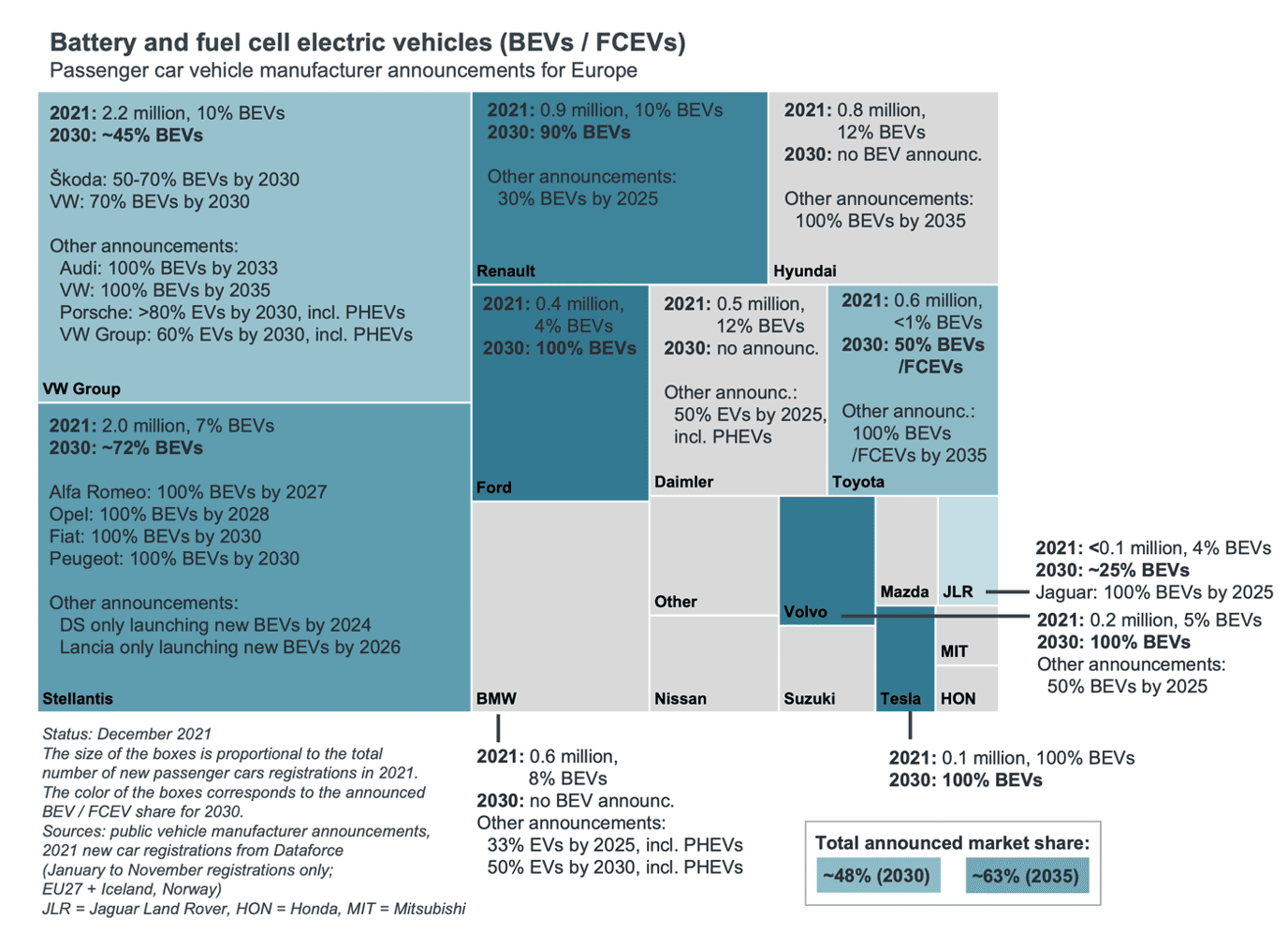Blog
Raising the bar: French and Italian manufacturers are leading on electric vehicle target announcements
The market share of battery-electric vehicles (BEVs) among new passenger car registrations in Europe increased fairly quickly, from about 2% in 2019, to nearly 6% in 2020, and to approximately 9% in 2021 (January to November). The European Union’s CO2 standards for vehicle manufacturers, set at an average target level of 95 g/km (NEDC) for 2021, are certainly a key factor influencing this recent uptake of electric vehicles. The next stages of the EU standards include a 15% CO2 reduction target for new cars by 2025 and a -37.5% target for 2030. For 2035, as part of its FitFor55 regulatory package, the European Commission proposed a -100% CO2 target—i.e., a full phase-out of new combustion engine vehicles. Even though the Commission proposal still needs to go through the legislative process, with the European Parliament and the EU Member States weighing in, vehicle manufacturers are already adapting their strategic product plans. A number of manufacturers have already come forward publicly with announcements regarding their plans for the market share of fully electric vehicles in future years (Figure 1).

Figure 1. Overview of vehicle manufacturer announcements for the expected share of battery and fuel cell electric vehicles in Europe.
With Stellantis and Renault, manufacturer groups with strong ties in France and Italy are currently leading regarding expected uptake rates of BEVs. Stellantis accounts for about 2.0 million new car registrations, of which in 2021 about 7% were BEVs. The two largest Stellantis’ brands, Fiat and Peugeot, both have publicly announced intentions to sell 100% BEVs by 2030. Alfa Romeo and Opel, two additional brands under the Stellantis umbrella, have committed to 100% BEVs by 2027 and 2028, respectively. Together, these four brands account for nearly three quarters of Stellantis’ new car sales in Europe. Renault Group, with its headquarters based near Paris, accounts for about 0.9 million new car registrations and is thereby the third largest manufacturer in Europe. In 2021, about 10% of new Renault cars were BEVs. The group publicly announced plans to sell 30% of its new cars as BEVs by 2025 and 90% by 2030.
Other progressive manufacturer statements include those from Ford (100% BEVs by 2030) and Volvo (50% BEVs by 2025, 100% by 2030). Together both manufacturers account for about 0.6 million of new car sales in Europe. Of course, Tesla is another manufacturer committed to 100% BEVs already today. And there is Jaguar, a brand accounting for about one quarter of new car sales of the Jaguar Land Rover group, that has committed to 100% BEVs by 2025.
Germany-based manufacturers, on the other hand, do not yet stand out with respect to clear BEV announcements. Instead, they are still hiding behind ambiguous statements that include plug-in hybrid vehicles (PHEVs). Europe’s largest manufacturer, the Volkswagen Group, accounts for 2.2 million new car sales, of which about 10% were BEVs in 2021. For 2030, the group has announced plans to sell 60% of new cars as electric vehicles, with no clear differentiation between BEVs and PHEVs. Only the VW and Škoda brands have committed to 70% and 50%–70% BEVs by 2030, respectively. The Audi brand has committed to 100% BEVs by 2033, and the VW brand has committed to the same by 2035. BMW and Daimler both came forward with announcements for 50% electric vehicles by 2030, again including PHEVs.
The Korean manufacturer group Hyundai, the fifth largest player on the European market, has also been surprisingly careful. Already today, 12% of all new Hyundai registrations in Europe are BEVs, which is the highest level of all manufacturers. And yet, the company has only mentioned 2035 as the target year for 100% BEV sales in Europe, and only for the Hyundai brand itself. Nissan, another forerunner with a 14% BEV share today, has only committed to 75% electric vehicle sales by 2030, including PHEVs. And then there is Toyota, with currently a BEV share below 1% and among the very rear of the pack. For its Lexus brand, the company committed to a 100% share of fully electric vehicles, i.e. battery or fuel cell electric vehicles, by 2030. But for the entire Toyota group, full electrification is only targeted for 2035, and with the caveat that “Toyota will be ready to achieve 100% CO2 reduction […] by 2035, assuming that sufficient electric charging and hydrogen refueling infrastructures are in place by then.” This is not really a courageous commitment in comparison to the statements of some other manufacturers.
If manufacturers meet the goals described in their statements, about 50% of new cars in 2030 would be BEVs. This is already much more than the 35% zero- and low-emission vehicle (ZLEV) benchmark target set by the European Commission for 2030. For 2035, manufacturer announcements add up to about 63% of new car sales being BEVs—an impressive number, considering that the 100% BEV proposal from the European Commission is not adopted (yet). Plus, it goes without saying that manufacturers are prepared to increase their commitments. Škoda’s CEO put it nicely by stating in an interview: “However the transformation from the combustion engine to the electric vehicle will further develop, we will maintain our high flexibility and can adjust re-accordingly. We certainly can further increase our current 70% target” (translated from German). In light of these developments, one should think that it will not take too much courage from the European Parliament and the EU Member States to confirm the Commission’s 2035 phase-out target for new combustion engine vehicles—or even to further strengthen it.
